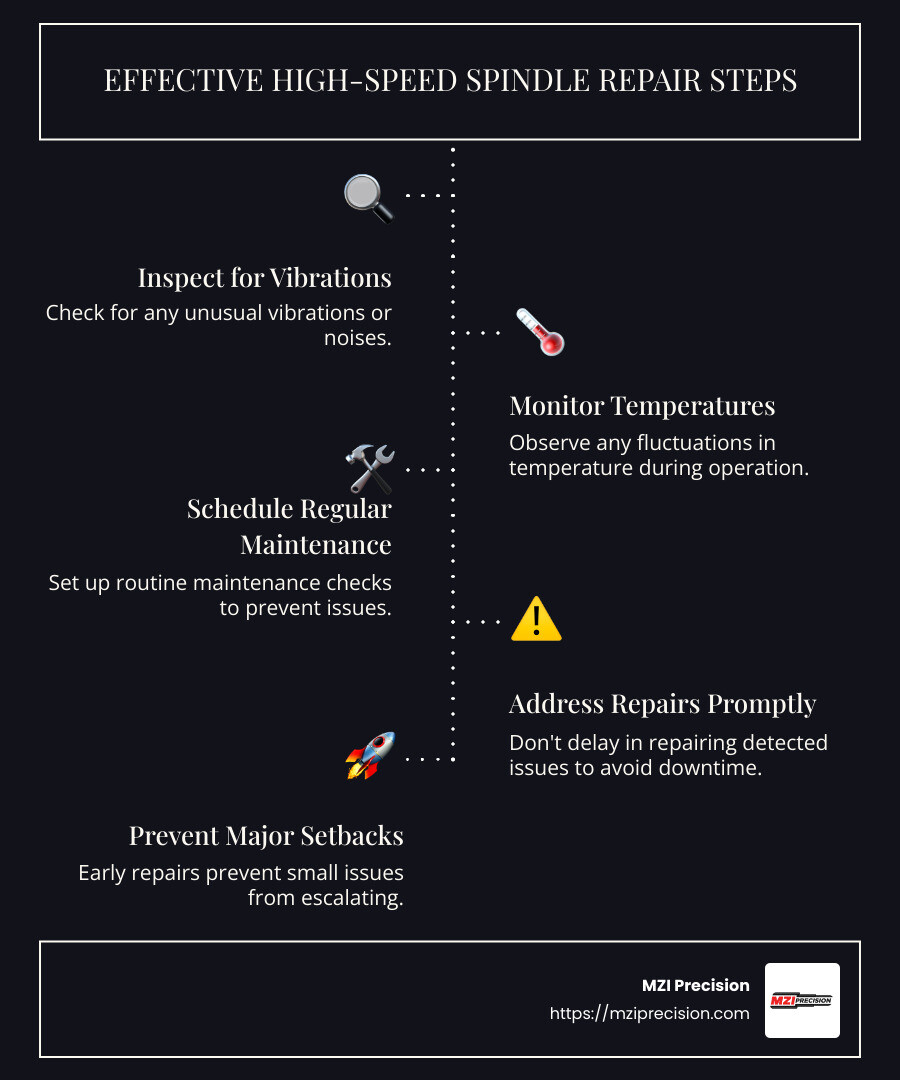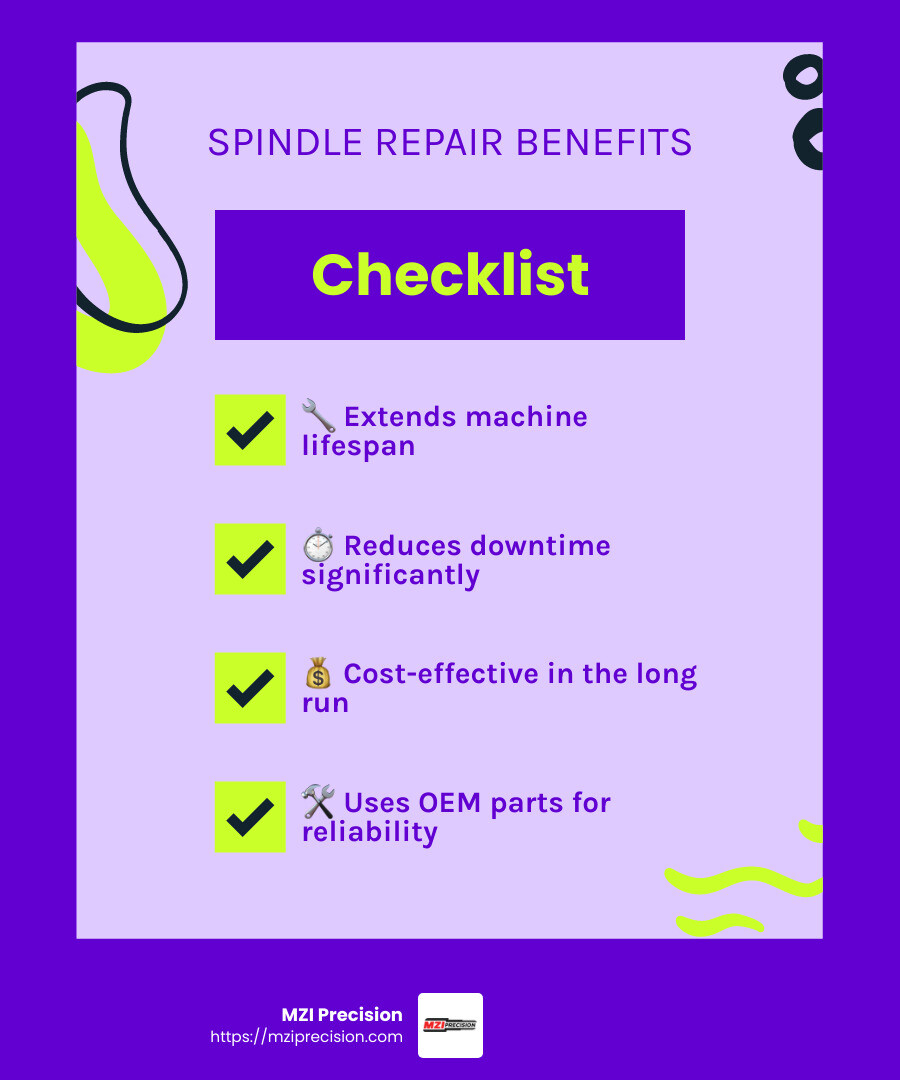High speed spindle repair is critical for maintaining the productivity of industrial machinery and avoiding production challenges. High-speed spindles are essential components in many CNC machines, relied upon for their precision and capability to operate at speeds exceeding 30,000 RPM. But like any other vital equipment, they are susceptible to wear and tear, which can lead to unexpected downtime and costly repairs if not addressed promptly.
To quickly address high speed spindle repair needs:
- Inspect for unusual vibrations or noises
- Monitor temperature fluctuations during operation
- Schedule regular maintenance to prevent sudden breakdowns
These simple steps can improve operational efficiency and ensure your machinery keeps running smoothly.
Spindle repair is not just about fixing what’s broken; it’s about preventing downtime and maintaining the smooth operation of your production lines. In industries where precision and timing are crucial, a failing spindle can be akin to a heart stopping in a body—everything grinds to a halt. By addressing spindle repair needs early on, you prevent small issues from becoming major setbacks.

Essential High speed spindle repair terms:
Understanding High-Speed Spindles
High-speed spindles are the heart of CNC machines, driving the precision and efficiency needed in modern manufacturing. These spindles can operate at speeds over 30,000 RPM, enabling rapid material removal and high-precision machining. Let’s explore what makes these components so crucial.
Precision Machining
In precision machining, the spindle’s role is to rotate the cutting tool or workpiece at high speeds, allowing for accurate and fine cuts. This precision is vital in industries where tolerances are tight, and errors can be costly. High-speed spindles help achieve the smooth finishes and exact dimensions required in sectors like aerospace and electronics.
CNC Machines
CNC (Computer Numerical Control) machines rely heavily on high-speed spindles for their operation. These machines use pre-programmed software to control the movement of the spindles, ensuring consistent and precise cuts. The high-speed spindle’s ability to maintain accuracy at high speeds is what makes CNC machines a staple in industrial manufacturing.
Spindle Components
Understanding the components of a high-speed spindle helps in recognizing the importance of regular maintenance and repair. Key components include:
- Bearings: These support the spindle shaft and allow it to rotate smoothly. High-quality bearings are crucial for minimizing friction and wear.
- Shaft: This is the central part of the spindle that rotates. It’s typically made from high-strength materials to withstand the stresses of high-speed operation.
- Motor: The motor powers the spindle, and its efficiency directly affects the spindle’s performance.
- Cooling System: To prevent overheating, spindles often have integrated cooling systems. Proper cooling is essential for maintaining performance and extending the spindle’s lifespan.
Each component plays a critical role in the spindle’s overall function. When one part fails, it can affect the entire system, leading to reduced precision and increased downtime.
By understanding these elements, manufacturers can better appreciate the importance of high speed spindle repair and the role it plays in maintaining the efficiency and longevity of CNC machines.
Next, we’ll explore the signs that indicate when a spindle might need repair, helping you catch potential issues before they escalate.
Signs Your Spindle Needs Repair
Recognizing the signs that your high-speed spindle needs repair can save your manufacturing operation from costly downtime and inefficiencies. Here are the key indicators to watch for:
Vibration Issues
Excessive vibration is a common sign that your spindle may be in trouble. Vibration can stem from worn components like bearings or an imbalanced shaft. When a spindle vibrates, it can cause poor machining quality and even damage the spindle itself. This issue often manifests as chatter marks on machined parts, which indicate a problem with spindle balance. If left unchecked, these issues can lead to costly downtime and further damage to the spindle.
Temperature Fluctuations
An increase in operating temperature is another red flag. Spindles are designed to operate within specific temperature ranges, and overheating can suggest an overload or a failure in the cooling system. If your spindle runs hotter than usual, address the issue promptly. Overheating can lead to the deterioration of spindle components, such as bearings and seals, which in turn affects performance and longevity. Regularly monitoring spindle temperature can help prevent these problems from escalating.
Production Downtime
Frequent or unexpected production downtime is a strong indicator that your spindle might need attention. A spindle in poor condition can cause a machine to slow down or stop altogether, impacting production schedules and increasing operational costs. Addressing spindle issues before they lead to significant downtime can save your operation time and resources.
By keeping an eye out for these signs, you can ensure your spindles are in optimal condition, maintaining the efficiency and precision that your manufacturing processes demand. Next, we’ll dig into the high-speed spindle repair process, which addresses these issues and restores your spindle to peak performance.
High-Speed Spindle Repair Process
Repairing a high-speed spindle is a detailed process that involves several critical steps. Let’s walk through each stage to understand how professionals bring these essential components back to optimal performance.
Evaluation
The first step in the high-speed spindle repair process is a thorough evaluation. Technicians assess the spindle to determine its condition and identify the root cause of any issues. This involves checking for signs of wear, imbalance, or damage. A detailed report is generated, outlining the findings and proposed repairs. This initial stage is crucial for planning the repair process and estimating costs.
Disassembly
Once the evaluation is complete and repairs are approved, the spindle is carefully disassembled. Each component is examined for wear and damage. This step is vital because it allows technicians to identify parts that need replacement or refurbishment. The disassembly process must be done carefully to avoid further damage and ensure that all parts are accounted for.
Cleaning
After disassembly, all spindle components undergo a thorough cleaning. This typically involves using a hot, ultrasonic cleaner to remove any debris, dirt, or old lubricants. Clean components are essential for accurate reassembly and reliable performance. Proper cleaning also helps in detecting any hidden damage that might not be visible when the parts are dirty.
Reassembly
With clean and repaired components, the spindle is ready for reassembly. New parts, such as bearings, are installed following precise procedures. The reassembly process is executed with great care to ensure that all components are aligned and fitted correctly. This step is crucial for achieving the spindle’s original precision and balance.
Testing
Finally, the spindle undergoes rigorous testing to verify its performance. This includes run-in tests, balancing, and vibration analysis. Technicians check the spindle’s speed, temperature, and vibration levels to ensure it meets the required specifications. Only after passing these tests is the spindle deemed ready for return to the client.
By following this comprehensive repair process, you can ensure your high-speed spindle is restored to its best condition, minimizing downtime and extending the life of your equipment. Next, we’ll explore the benefits of professional spindle repair and how it contributes to machine longevity and cost efficiency.
Benefits of Professional Spindle Repair
Professional spindle repair offers several key benefits that can significantly improve the performance and reliability of your industrial machinery. Let’s dig into how these services contribute to machine longevity, reduced downtime, and cost efficiency.
Machine Longevity
A well-maintained spindle is crucial for the longevity of your machinery. Professional repair services ensure that each component of the spindle is thoroughly inspected and restored to its optimal condition. By replacing worn-out parts and using high-quality materials, professionals can extend the life of your spindle. This not only prevents frequent breakdowns but also ensures that your machines operate at peak performance for longer periods.
Reduced Downtime
One of the most immediate benefits of professional spindle repair is the significant reduction in machine downtime. When a spindle fails, it can cause production to halt, leading to costly delays. By utilizing expert repair services, you can quickly return your machines to operation. Skilled technicians use advanced diagnostic tools to identify issues swiftly and accurately, allowing for faster repairs and minimal disruption to your production schedule.
Cost Efficiency
Investing in professional spindle repair is a cost-effective solution in the long run. While the initial repair cost might seem significant, it is far less than the expense of replacing an entire spindle or dealing with prolonged machine downtime. Additionally, professional repairs often include the use of Original Equipment Manufacturer (OEM) parts, which provide better fit and performance, further enhancing the spindle’s durability.

By opting for expert repair services, you not only save on immediate repair costs but also benefit from increased efficiency and productivity. This makes professional spindle repair a smart financial decision for any industrial operation.
In summary, professional spindle repair is an investment in your machinery’s future, offering significant benefits in terms of longevity, reduced downtime, and cost savings. Up next, we’ll address some frequently asked questions about high-speed spindle repair to further guide you in maintaining your equipment.
Frequently Asked Questions about High-Speed Spindle Repair
What are common causes of spindle failure?
Spindle failure is often caused by wear and tear and improper maintenance. Over time, the constant high-speed rotation and heavy use lead to natural degradation of spindle components. Bearings, for instance, can wear out, causing the spindle to function improperly. Contamination, such as dust or coolant infiltration, can also lead to increased wear. Regular inspection and maintenance can help identify these issues early on, preventing more severe damage.
How often should spindles be serviced?
The frequency of spindle servicing depends on the usage frequency and the specific demands of your operations. For high-speed spindles, it is recommended to conduct regular maintenance checks every few months. This includes vibration analysis, lubrication, and checking for any signs of wear. Regular servicing ensures that spindles operate efficiently and helps prevent unexpected failures that could disrupt production.
What is the typical cost of spindle repair?
The cost of spindle repair can vary based on the extent of the damage and the specific services required. Generally, repair costs are more economical than replacing a spindle entirely. Service pricing typically includes inspection, disassembly, cleaning, and reassembly. While initial repair costs may seem high, investing in professional repair services can save money in the long run by extending the spindle’s life and reducing downtime. Using OEM parts can also add to the cost but ensures better performance and longevity.
Conclusion
At MZI Precision, we understand that when your machines are down, your business is at a standstill. That’s why we are committed to providing exceptional service and expertise in high-speed spindle repair. Our focus is on getting your industrial manufacturing operations back up and running smoothly, minimizing downtime and maximizing efficiency.
Our team excels in rebuilding OEM spindles, ensuring that each component meets or exceeds the original specifications. With years of experience working with a wide range of spindle brands and models, we have the knowledge and skills to handle even the most complex repairs with confidence.
Choosing MZI Precision means choosing a partner who is dedicated to delivering top-quality repairs and support. We back our work with a full one-year in-service warranty, so you can trust in the longevity and reliability of our repairs. Our commitment to customer satisfaction and precision machining makes us the ideal choice for all your spindle repair needs.
Let us help you keep your machines running at their best. Explore our precision spindle services and find how MZI Precision can support your industrial manufacturing operations today!



